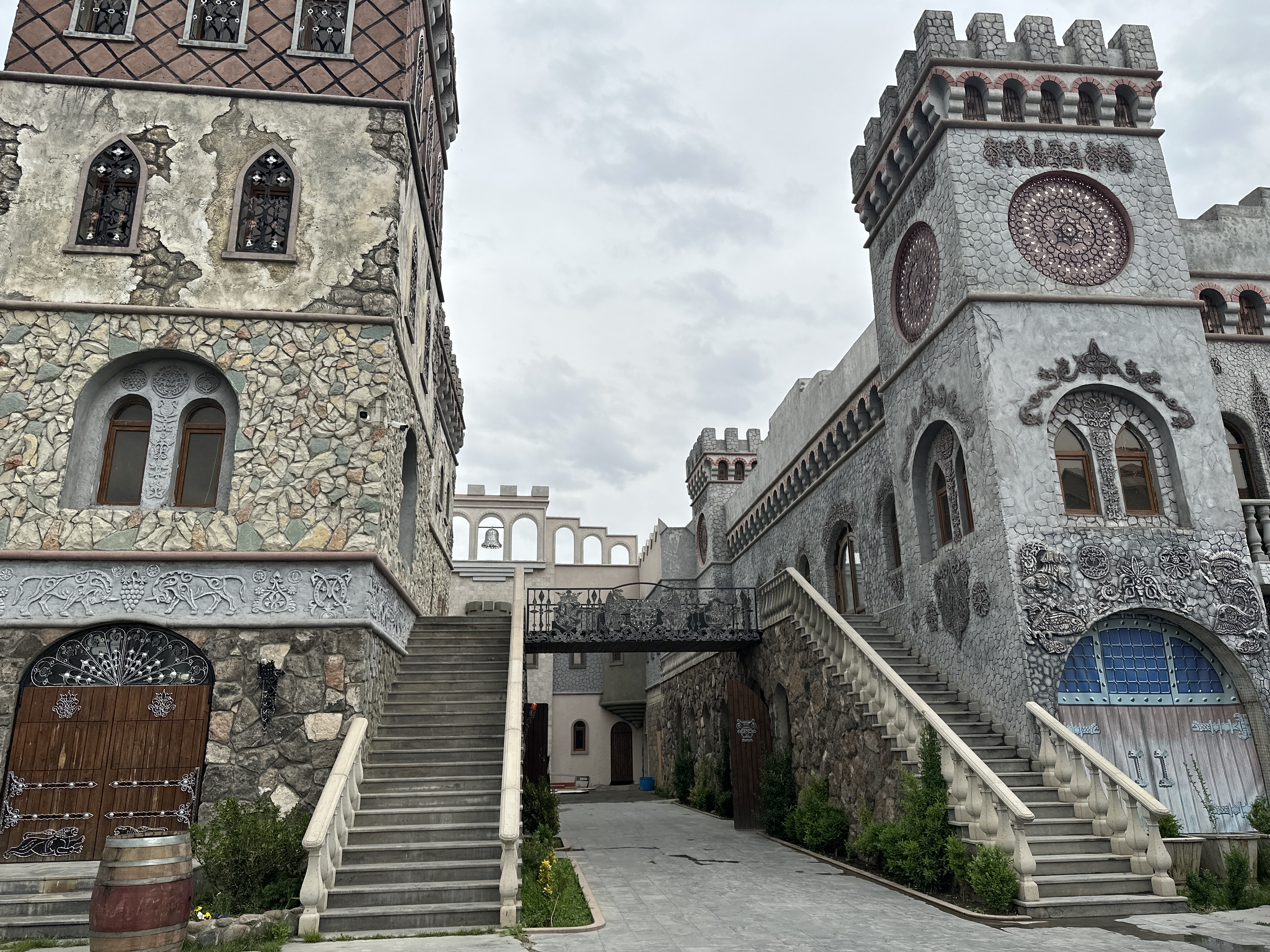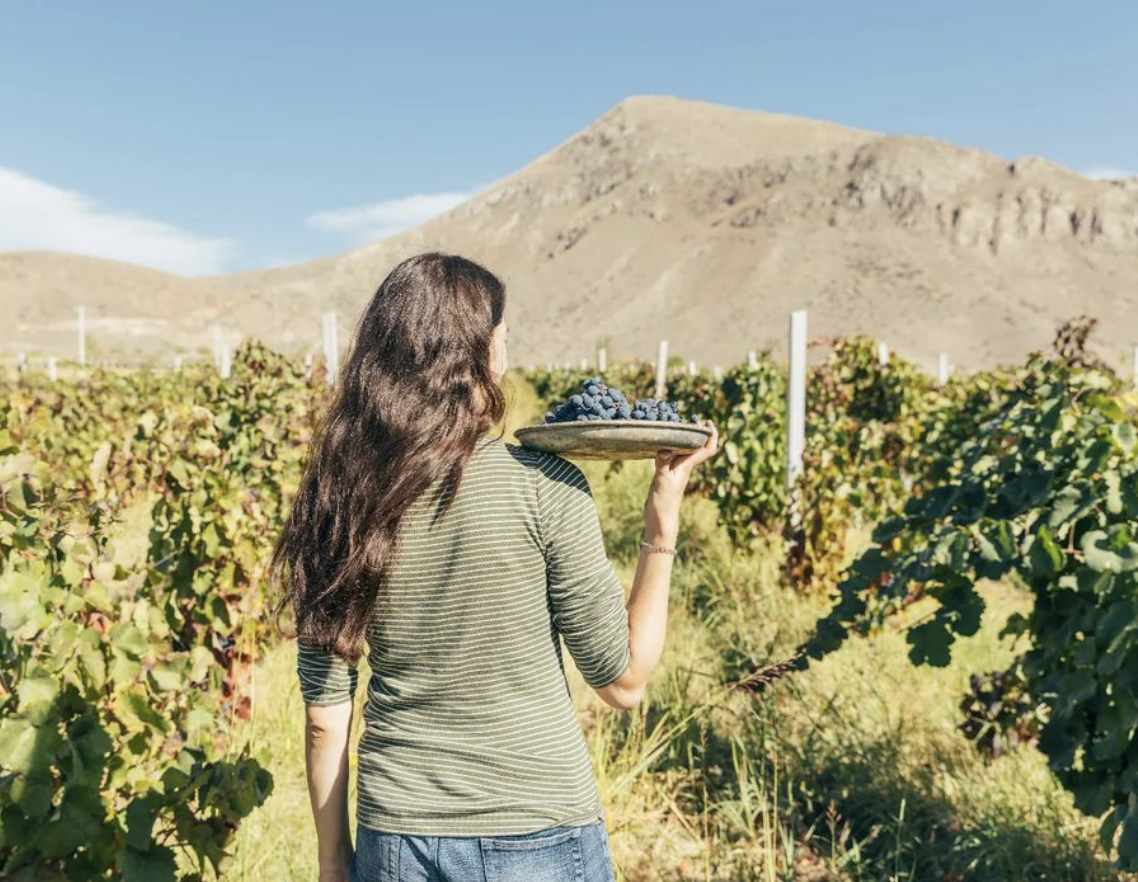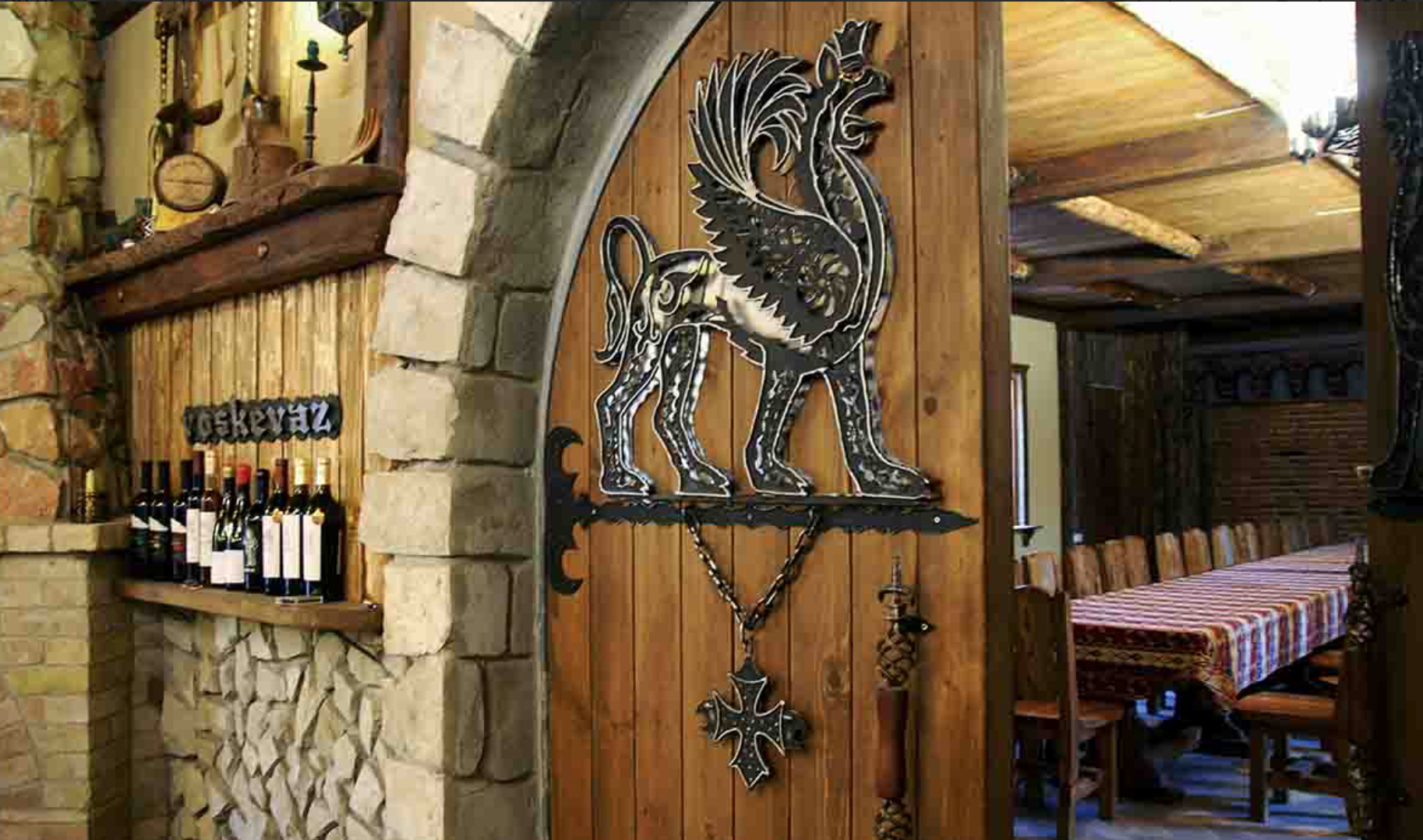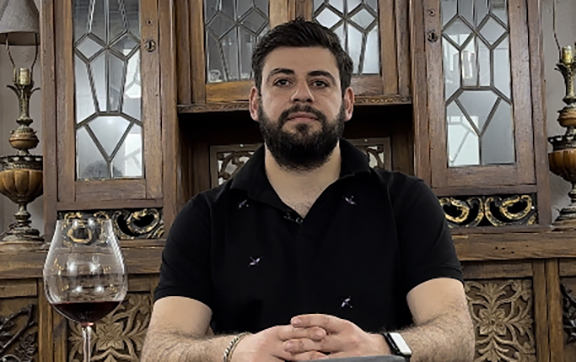Nestled in the heart of Armenia, a country with a rich history of winemaking dating back thousands of years, Voskevaz Winery stands as a testament to the enduring tradition of viticulture in the region. Situated in the picturesque Aragatsotn region, this winery embodies the essence of Armenian winemaking, blending ancient techniques with modern innovation to produce exceptional wines.
The name "Voskevaz" itself carries historical significance, translating to "golden bunch" in Armenian. It reflects the winery's commitment to cultivating and crafting wines of the highest quality, akin to a precious cluster of golden grapes. Established in 1932, Voskevaz Winery has evolved over the decades, embracing advancements in winemaking while preserving the cultural and historical roots deeply embedded in the Armenian soil.
 One of the distinguishing features of Voskevaz Winery is its dedication to indigenous grape varieties. Armenia boasts a unique array of grapes, some of which are found nowhere else in the world. Voskevaz Winery carefully tends to these native varieties, such as Areni and Voskehat, preserving the authenticity and distinctiveness of Armenian wines.
One of the distinguishing features of Voskevaz Winery is its dedication to indigenous grape varieties. Armenia boasts a unique array of grapes, some of which are found nowhere else in the world. Voskevaz Winery carefully tends to these native varieties, such as Areni and Voskehat, preserving the authenticity and distinctiveness of Armenian wines.
Voskevaz Winery embraces both traditional and modern winemaking techniques. The winemakers pay homage to the ancient tradition of "karas" winemaking, where grapes ferment and age in large clay vessels buried underground. This method, passed down through generations, imparts a unique profile to the wines. However, the winery also incorporates modern equipment and expertise to ensure consistency and quality throughout the winemaking process.
A flagship wine for Voskevaz Winery is the Areni Reserve, made from the indigenous Areni grape variety. This red wine showcases the depth and complexity that Armenian terroir can offer, with notes of red berries, spices, and a hint of minerality. The Voskehat Reserve, a white wine crafted from the native Voskehat grape, exemplifies the winery's dedication to expressing the full potential of Armenian varietals, displaying a harmonious balance of floral aromas and crisp acidity.
Beyond winemaking, Voskevaz Winery places a strong emphasis on sustainable and eco-friendly practices. The winery actively participates in initiatives aimed at preserving the environment and supporting local communities. By integrating modern technology with traditional values, Voskevaz Winery strives to be a responsible steward of the land, ensuring the longevity of Armenian winemaking for future generations.
Grape Collective talks to second generation winery owner Mary Hovhanisyan and Voskevaz winemaker Ghevond Petrosyan about the evolution of Armenian wine.
Piers Parlett: Tell us about the history of Voskevaz.
 Mary Hovhanisyan: Voskevaz Winery is located in the Aragatsotn region, in the village Voskevaz (the same name as the winery) which translates to ‘golden bunch’. It was decided by the government to create a winery here in 1932. So we are situated in the oldest functioning winery in Armenia, and there is a reason for that because the Aragatsotn region was very developed in producing sherry type wines. In all of the Soviet Union, only three countries produced sherry type wines, which were Moldova, Ukraine and Armenia, and mainly in the Aragatsotn region.
Mary Hovhanisyan: Voskevaz Winery is located in the Aragatsotn region, in the village Voskevaz (the same name as the winery) which translates to ‘golden bunch’. It was decided by the government to create a winery here in 1932. So we are situated in the oldest functioning winery in Armenia, and there is a reason for that because the Aragatsotn region was very developed in producing sherry type wines. In all of the Soviet Union, only three countries produced sherry type wines, which were Moldova, Ukraine and Armenia, and mainly in the Aragatsotn region.
(Mary Hovhanisyan)
Only here was sherry type yeast developed, so it gave us the opportunity to produce the sweet wines which were exported all over the Soviet Union and became very famous. And mostly, of course, at Voskevaz they worked with the Voskehat grape variety, which is the queen of our white grape varieties, the flagship grape of this region. As a family, our journey with this winery began in 1998. Before that, unfortunately, the winery was abandoned because it was not the primary field of interest for the government and so it was abandoned. No production was going on at the winery and they just left it as it was.
So my father David Hovhanisyan, who is the founder of the company, bought the winery. I didn't quite understand what we would do with this winery because then it was not as beautiful as you can see it is right now. So we didn't know what to do with it. But he had this vision. He had this dream to show to the international consumer what it is to produce high quality Armenian wines only from local grape varieties.
And our primary goal was to show it to our consumer, to the Armenian consumer, because as you know, there was this separation. Armenia produced only brandy, and Georgia produced only wine during the Soviet period. And this is a shame because Armenia is known as a cradle of winemaking. It has a rich history starting from Noah, and the Areni-1 Cave. It was very developed in our culture to drink wine, and then it was just extracted from our culture. There were no documents. During the Soviet period in Armenia, there was no research, there was no documentary. There was nothing. There was no development in this field.
It was mainly brandy production in Armenia and luckily in our region, Aragatsotn region, we got a bit luckier because we had the Voskehat grape variety, which was very good for brandy production. So they kept the vineyards here, some of the vineyards, but unfortunately, the Vayots Dzor region, the Ararat Valley, and some other regions were less fortunate because there they had mostly red grape varieties.
There are vines that we have in Armenia, old vines that are very highly situated, 1,600 meters above sea level, that were hidden with the help of the farmers that loved their work, loved their craft, and they just hid these vines from the government during the Soviet era separation. And now we still have these beautiful old vines that are situated in different regions.
So we started to revive wine production here at the winery as a family winery, and mostly we concentrated on the autochthonous varieties. This is our main philosophy of the winery, Armenian style. Armenian grape varieties and only Armenian oak are used in our premium range wines and middle range wines.
 Also the most interesting traditional technologies we are starting to revive. These are the Karasi Collection wines and kakhani wines. Karas is a clay amphora, which has a rich history of six, seven, 8,000 years that were used not only for wine production but also for different liquid transportation back then. The "kakhani" method is the traditional way of gentle rope-drying of carefully selected bunches of grapes, which creates a very concentrated style of wine.
Also the most interesting traditional technologies we are starting to revive. These are the Karasi Collection wines and kakhani wines. Karas is a clay amphora, which has a rich history of six, seven, 8,000 years that were used not only for wine production but also for different liquid transportation back then. The "kakhani" method is the traditional way of gentle rope-drying of carefully selected bunches of grapes, which creates a very concentrated style of wine.
We are in love with Armenian winemaking and we wanted to revive it and give a new touch to it. And so we started to experiment and Voskevaz adores experimenting. We are working with our winemakers and we give them these proposed quantities of experiments per year. We decide how many experiments we will do because we have to evolve, we have to do something new as we didn't have anything to work with in terms of scientific work from the past.
We didn't know how to combine, how to blend, what Armenian grape variety will look good in different types of wood vessels and how many months should we age wines in each tank. So we started from scratch. By saying ‘we’, I mean not only Voskevaz, but also all the other winemakers, our fellow Armenian winemakers. They started to work with winemaking and started to revive it with us 10, 15 years ago. And what we are doing now as a winery, what we are doing now with winemakers, it is this data, this basis of knowledge, that we are developing so that we can later pass it on to the younger generation of winemakers and they can have this data to start with.
How was the winery different under Soviet government control?
Back to the times when the winery was governmental and it was producing wine under the Soviet government it was a very different winery. It was more technical. It was devoted to more mass production wines, cheaper wines, mostly from white grape varieties, because Aragatsotn is very famous for its white grape varieties. It was mainly Voskehat, and had a bit of the Kangun grape variety. But mainly Voskehat was the grape that the wine was produced from.
It was also very technical. There were no winemakers, they were technologists. So it explains how the winery was operating, how it produced the wine. It was mainly for exports. Here at the winery we produced sherry type sweet wines and they were produced and exported all over the Soviet Union and that was the main wine that we were working with back then.
So when we go through the winery we will see how the winery was working with old tanks. So it was fermented and aged there and it was the technologists that decided that the wine was ready. It was with these vessels, that these technologists worked to produce cheap, high production wine.
During the communist period in Armenia regarding winemaking, it was all centralized. It was all in communication with Moscow. And it was very technical. It was a great separation. Everything was thought through. This country produces this type of product, another country another type of product and it was very easy for a central government to control the export and import of the products. That is why it was this separation.
In terms of winemaking. It started as dry law in this region and there were some restrictions for wine consumption, alcohol consumption, and then it changed and transitioned and developed to this separation of country production. So Armenia was said to produce brandy mostly and Georgia was to produce wine, and that is why we unfortunately have missed 70, 80 years of development in this field.
 So we look at Armenia as a wine producing region from starting around 8,000 years ago as we know. There is a big responsibility for us as winemakers, as a winery, because we have this heavy heritage that we want to show in a new way to our consumers. And that is why we like to experiment and show it with a new touch. And so that is how we created our Voskevaz Karasi Collection allowing us to experiment with amphora, with karas.
So we look at Armenia as a wine producing region from starting around 8,000 years ago as we know. There is a big responsibility for us as winemakers, as a winery, because we have this heavy heritage that we want to show in a new way to our consumers. And that is why we like to experiment and show it with a new touch. And so that is how we created our Voskevaz Karasi Collection allowing us to experiment with amphora, with karas.
We measured how much after the fermentation the wines would age in an Armenian oak barrels. And after some years of experiments, we finally have this product which is a beautiful, elegant wine that shows the heritage of Armenia. It shows a combination of and a marriage of endemic grape varieties and Armenian clay amphora, of Armenian old barrels.
So this combination is very highly appreciated abroad, not only in Armenia. Many wine critics came to this region seeking authentic wine. They were looking for some extraordinary wine that was mainly produced by hand with authentic grape varieties and very interesting clay amphoras. And they are coming here to this region to see this unique wine, which they can't find in other places in the world.
Where is Armenia geographically, for those who don’t know?
Armenia is a landlocked country. Armenia is located in the Caucasus and is surrounded by countries like Georgia, Turkey, Iran, and Azerbaijan. And we don't actually have a road from Armenia to Europe. So It is a bit complicated in exporting products to European countries, to the USA and other places. But as you can see, we are managing to deal with every difficulty that is before us.
So whether is it exporting, whether is it importing some supplies from European countries, whether is it a difficult political situation, we are still managing to grow grapes and to produce high quality wines from it, and to show to the wine world that Armenia has its own place and can bring to the world wine map beautiful, elegant, well-balanced Armenian wines.
What happened in Armenia after communism?
So after communism, after the Soviet period, we can now see the renaissance of a wine drinking culture, wine producing culture, because it was not developed in Armenia for a long, long time. For 70 years, 80 years maybe. And now what we see in Armenia is very fascinating for us because then it would have been impossible to imagine that you could have seen Armenian wine evolve to what it is today. Then was mainly brandy, vodka, beer and no wine at all because the wine at the time was not well-made. And it was also not common in the culture to drink wine. And what we see now, what we see on the streets and at our winery, everybody drinks wine, everybody loves wine.
And 15 years ago, 20 years ago, it was considered to be mostly a feminine alcoholic beverage, and men didn't drink wine at all. So now everybody drinks wine. Everybody loves it, no matter whether it is white, red or rosé, sweet or dry. From our experience, from our wines, we are selling more intense, full bodied wine for women and more Muscat wines or rosé wines for men. They adored them as they are light and appetizer wines and women like these full bodied, full tannins wines.
Armenia is a Christian country?
Armenia was the first country to adopt Christianity as a religion, and after that everything was connected with Christianity. Even before, when Armenia was a pagan country, it was also surrounded with wine history. And everybody made wine back then, 7,000, 8,000 years ago.
We can see also in the Areni-1 Cave in the Vayots Dzor region which is dated back 6,100 years ago that it was very common to produce wine. It has been proven that we had the oldest winery in the world which was found during the archeological excavations.
 After that, in 300 AD we adopted Christianity. And also at this point it was crucial to adopt this winemaking culture in Christianity, which was done very perfectly. We have this very interesting heritage of winemaking in Pagan times and also in the Christian era.
After that, in 300 AD we adopted Christianity. And also at this point it was crucial to adopt this winemaking culture in Christianity, which was done very perfectly. We have this very interesting heritage of winemaking in Pagan times and also in the Christian era.
We can see all of the symbols that were connected to both of the eras, because in each time period in Armenia, it was very honorable to work with grapes. In both the Pagan era and the Christian era it was very honorable to work with wine, to grow grapes, to produce homemade wine and that is why at our winery we will also be able to see on our buildings the symbols connected with both the Pagan and Christian eras.
What are your hopes for the future of Armenian wine?
As I see it in the future, it is very bright because right now at this moment we see the wine renaissance in its full beauty. We see different regions developing, evolving. We see the experimental new winemaker era where they aren’t afraid to experiment, they aren't afraid to do some crazy work with wines. They are open to new things. They are open to combining here heritage winemaking tools with new tools or European style or American style.
And what we see in Armenia is only the beginning, because I think that in five years or ten years, we will be very, very far from the point that we are now. We are developing very fast. If we see what was happening before 2000 and what is happening after it, this is a very huge step and it is very fascinating how this field will develop in the future.
-----------------
 How did you become a winemaker?
How did you become a winemaker?
Ghevond Petrosyan: So I started my winemaking journey in 2010, and after graduating university, I moved to Germany, studying in Geisenheim University and started to work in a German winery which mostly concentrated on production of white wine because it’s Germany. After that, in 2019, I moved back to Armenia, and now I'm working in the Voskevaz Winery as a winemaker.
This region has a very rich, unique winemaking history. This region is concentrated on production of karases, the amphoras made from clay. Now unfortunately we have lost the tradition of making amphoras, but in our winery we still use amphoras and the average age of our amphoras is 130 years old.
Tell us about your region, the Aragatsotn region.
 We have here a very unique terroir, unique soil with a sandy clay ash. The altitude is approximately 1,000 meters and up, and the main variety here is the Voskehat, the flagship white variety in Armenia.
We have here a very unique terroir, unique soil with a sandy clay ash. The altitude is approximately 1,000 meters and up, and the main variety here is the Voskehat, the flagship white variety in Armenia.
So in our region, the Aragatsotn region, each family had amphora in ancient times and it was very popular to make homemade wine for use the whole year round. The most popular variety was the Volskehat variety. In translation it means ‘golden berry’. It is a very sensitive variety in the vineyards.
What is a karas?
Karas is a pot, an amphora, made from clay. It is important in the history of Armenian winemaking, because in ancient times the production of the wine and storage of the wine happened only in the amphoras. When families want to build a house they would put in a karas first and then build the walls around it. So in old houses we can find very big amphoras in the cellars but they are impossible to move due to the size. There can be up to two tons of liquid volume in these karas.
And now in our winery we are reactivating this tradition of making wines from amphora. In our winery we are using between 800 to 1,200 liter amphoras. We officially released our first amphora wine in 2014, though we started to experiment with amphora years before that. We started this as one of the goals of the winery, to focus on premium wines and to reactivate Armenian winemaking traditions.
I will point out the minerality and the aromas we get in wines made in amphora that we cannot get from wines made in other materials such as wood or stainless steel tanks.
Also I will tell a very interesting story of Voskehat, because in ancient times Voskehat was used for barter. When people wanted to pay some money to the workers they would give the Voskehat variety as payment. We work with the Voskehat to barter with our neighbors. We give some Voskehat and take some leather and other goods.
How would you describe the winemaking in Armenia today?
We have had a large evolution of winemaking in Armenia. So now we will say we are in the renaissance in the last ten to fifteen years. Armenian winemaking continues to improve. It all starts with the Armenian varieties, Voskehat, Areni. These are varieties you can not find outside of Armenia. The aromas and taste of our varieties are very unique.
We have a tradition of making wine that goes back 6,100 years which is proven as scientific fact from the Areni-1 Cave in the Areni village. Now in Armenia we are reactivating this tradition, through making wine in karases. In Armenia in the last 15 years, Armenia has been experimenting a lot and trying to explore our native varieties.
What is your philosophy of winemaking?
My main philosophy is making more organic wine. To make wine without using pesticides in the vineyards, to make high quality wine that represents Armenia. So I represent the younger generation of winemaking in Armenia. We are more open and we share our experiences with each other.
The winemakers like to drink wine, and only Armenian wine is not enough for us. We are going abroad, and we are drinking other wine. We are experimenting a lot and trying to help develop an Armenian wine style.










